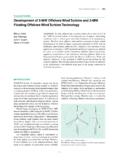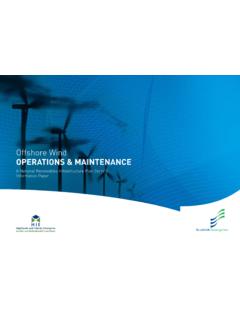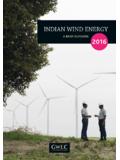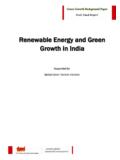Transcription of Prepared by MMI Engineering Ltd for the Health …
1 Health and Safety Executive Study and development of a methodology for the estimation of the risk and harm to persons from wind turbines Prepared by MMI Engineering Ltd for the Health and Safety Executive 2013 RR968 Research Report Health and Safety Executive Study and development of a methodology for the estimation of the risk and harm to persons from wind turbines CME Robinson PhD CEng MIMech ES Paramasivam PhD EA Taylor PhD MInstP MRAeS AJT Morrison BEng CEng MICE MIStruct ED Sanderson MA CEng MIMechE MMI Engineering Ltd The Brew House Wilderspool Park Greenall s Avenue Warrington WA4 6HL wind power is becoming an increasingly significant contributor to the UK energy mix and a significant proportion of this is onshore.
2 Onshore wind power generation ranges from large utility scale wind farms, through medium size brownfield type developments, to the small end domestic wind power generation. Although HSE is only a statutory consultee for developments of 50 MW or larger, HSE is often approached for advice on new wind developments at all scales. A number of organisations have previously provided risk assessments for wind power developments, but these are normally bespoke to a particular application. The work presented in this report has two main components. Firstly, research has been carried out to determine publicly available data for wind turbine failures and failure rates. Data has been drawn from a number of sources, including: HSE incident reports, a trade association, a renewable energy research organisation, web-based literature and published papers.
3 The second component to the work has been to develop a standard methodology for the risk assessment of harm to people from wind turbine failures. This methodology produces contours of probability of harm, and fatality by direct and indirect impact of thrown wind turbine blades or blades fragments. The contours produced by the methodology may be assessed as Location Specific Individual Risk when they are combined with the frequency of failure of the wind turbine. This report and the work it describes were funded by the Health and Safety Executive. Its contents, including any opinions and/or conclusions expressed, are those of the authors alone and do not necessarily reflect HSE policy. HSE Books Crown copyright 2013 First published 2013 You may reuse this information (not including logos) free of charge in any format or medium, under the terms of the Open Government Licence.
4 To view the licence visit , write to the Information Policy Team, The National Archives, Kew, London TW9 4DU, or email Some images and illustrations may not be owned by the Crown so cannot be reproduced without permission of the copyright owner. Enquiries should be sent to ACKNOWLEDGEMENTS The authors wish to acknowledge the assistance of the following individuals and organisations in providing data and comments to assist in the production of this report: Mike Bilio, Health and Safety Executive, National Renewable Energy Laboratory (NREL), a facility of the US Department of Energy, Chris Streatfeild, Director of Health and Safety, RenewableUK Nick Summers, Health and Safety Executive ii CONTENTS 1.
5 1 2. FAILURE DATABASE AND FAILURE ANALYSIS .. 3 Literature Survey 3 Methodology 3 Reported Blade Failures and Estimation of Failure Frequencies 3 wind Turbine Sub-Assemblies and Failure Modes 3 Failure Frequencies for Subassemblies 6 Incident Reports and Fragment Distribution Data 7 Collaboration with RenewableUK 8 Collaboration with NREL 8 Classification of wind Turbines 8 Description of Power Regulation and Over-speed Control Method 8 Component Materials 9 wind Turbine Failure Modes - Tower Collapse 10 wind Turbine Failure Modes Fire 10 wind Turbine Failure Modes Blades 11 Classification of Blade Failures 11 Normal Operation Mode Failures 12 Failure Modes - Tower Strikes 13 Failure Modes - Over-Speed 13 Failure Modes - Lightning 13
6 Failure Modes - Other 14 Description of the Nature of Blade Failures 15 3. HUMAN VULNERABILITY 17 Introduction 17 Direct Impact 17 Fragment Impact 17 Blunt Trauma 18 Recommendation 19 Indirect Impact 20 Smaller Fragments 20 Larger Fragments 20 Recommendation 21 4. HARM TRANSMISSION MODELS .. 23 Introduction 23 Literature Review 23 Existing Blade Throw Models and Limitations 23 Probability of wind Turbine Failure 24 Size of Installed wind Turbines 25 Proposed Blade Throw Model 25 Assumptions 25 Throw Model 26 Steps Involved in the Calculation of Throw Distance 28 [iii] 5. RISK ASSESSMENT METHODOLOGY .. 30 Introduction 30 Monte Carlo Simulation 30 Monte Carlo Algorithm 30 Data Distributions Used 31 Mass of the Blade 31 Exposed Area of the Fragment 34 Fragment Velocity 35 Drag Coefficient 35 Blade Angle at Detachment 36 wind Speed 36 wind Direction 36 Case Study 36 Description 36 Case Study Input Data 36 Case Study Results 38 Case Study Results Discussion 39 Case Study Results Sensitivity Study 46 Case Study Results Comparison with Societal Risks 50 6.
7 CONCLUSION .. 52 7. APPENDIX A METHOD TO ESTIMATE BLADE FAILURE 53 Foreword 53 Estimation Method 53 8. APPENDIX B SUMMARY OF DATA FROM THE wind ENERGY MARKET [31] .. 54 9. APPENDIX C VALIDATION OF THE BLADE THROW MODEL .. 67 Validation of the model 67 Case 1: Test without air resistance, no drag force. 67 Case 2: Test with air resistance, no wind 69 Case 3: With air resistance and wind 70 Sensitivity analysis for time step 71 10. APPENDIX D DATA DISTRIBUTIONS USED IN THE RISK METHODOLOGY .. 73 Uniform distribution 73 Beta distribution 73 Weibull distribution 73 Rayleigh distribution 73 Normal distribution 74 REFERENCES .. 75 [iv] EXECUTIVE SUMMARY In order to support its responsibilities for Health and safety the HSE commissioned MMI Engineering Ltd (MMI) to carry out this study to determine risks to persons in the vicinity of wind turbines.
8 The aims of the study have been two-fold: To carry out a literature search and industry survey to locate publicly available data which could be used reliably to develop failure rates for wind turbines; and, To produce a methodology to assess risk presented to persons from wind turbines. This methodology would be general in its format so that it could be applied to a wide range of cases. The literature review carried out has been wide ranging, using academic search engines in addition to web-based searches and liaison with a renewable energy industry professional and trade body. The literature search has confirmed that there is no readily available database meeting HSE s requirements for recording wind turbine failures.
9 However, there are a number of sources of data which are potentially of use to determine failure frequencies. To provide further information on wind turbine failures, MMI has collaborated with the US National Renewable Energy Laboratories (NREL, part of the US Department of Energy). NREL has provided further information on aspects of wind turbine design, construction operation and failure, which is included in this report. Several strands of development have been required to create the methodology for risk assessment for persons in the vicinity of onshore wind turbines. These have been the development of a human vulnerability model and a harm transmission model which have been brought together in the risk assessment methodology.
10 The human vulnerability model has been developed from literature searches and data on the vulnerability to persons from airborne debris. wind turbine failure can take a variety of forms but the assumption is made that a typical structural failure generates a range of debris sizes, masses and velocities. Human vulnerability to impact from debris falls into two broad categories: (i) direct impact: the debris from the failed turbine follows a trajectory and makes contact with one or more people; (ii) indirect impact: debris from the failed turbine follows a trajectory and makes contact with an enclosure housing one or more occupants; the enclosure then fails in some manner, collapsing onto the occupants.

















